REPLACEMENT WINDOWS IN LISTED BUILDINGS
In recent years the repair and maintenance of windows in listed buildings have given rise in many cases to their total replacement in materials which are alien to the listed building and shapes which are totally unsympathetic to the architectural and historic value of the building. It has become common in the last few years to use modern materials which are, according to the manufactures’ information, easy to clean and in most cases double glazed giving a high thermal efficiency. However, most of these new materials are entirely inappropriate when considering listed buildings and this leaflet sets out the requirement for consent for any changes, the recommended or appropriate materials and designs to be used and indicates those materials and designs which are inappropriate in either repair or replacement.
In recent years the repair and maintenance of windows in listed buildings have given rise in many cases to their total replacement in materials which are alien to the listed building and shapes which are totally unsympathetic to the architectural and historic value of the building. It has become common in the last few years to use modern materials which are, according to the manufactures’ information, easy to clean and in most cases double glazed giving a high thermal efficiency. However, most of these new materials are entirely inappropriate when considering listed buildings and this leaflet sets out the requirement for consent for any changes, the recommended or appropriate materials and designs to be used and indicates those materials and designs which are inappropriate in either repair or replacement.
LISTED BUILDING CONSENT
It is essential that listed building consent is obtained from the Local Planning Authority before any work is executed which is likely to alter or affect the character or appearance of a listed building. Such works include replacing windows and doors. PERSONS WHO CARRY OUT WORK WITHOUT THE NECESSARY CONSENT ARE GUILTY OF A CRIMINAL OFFENCE AND ARE LIABLE TO PROSECUTION AND ENFORCEMENT ACTION.
Instances involving listed buildings can lead to prosecution and will often necessitate enforcement action requiring the owner to remove the new windows and replace them with the originals, or if these have been destroyed with exact replicas of the original design. Owners of listed buildings are advised that this action can involve considerable expense which could easily be avoided if the Local Planning Authority advice is sought.
Should you have any questions regarding listed buildings and particularly replacement windows then contact the Conservation Officer at the Local Planning Authority who will be able to advise you on this matter.
APPROPRIATE MATERIALS AND DESIGN
Most of the windows in listed buildings fall into two categories, either sashes that include timber sliding sash and casements, or casement windows which are often side hung. A small proportion of the windows in listed buildings are cast iron windows and some of the very old style are fixed timber, in some instances with leaded lights. Replacement windows must always be of the same design and materials as the original and respect of the size and shape of the window opening and standard off-the-shelf windows should never be used since these nearly always require some cutting or addition to the window to make it fit properly.
Instances involving listed buildings can lead to prosecution and will often necessitate enforcement action requiring the owner to remove the new windows and replace them with the originals, or if these have been destroyed with exact replicas of the original design. Owners of listed buildings are advised that this action can involve considerable expense which could easily be avoided if the Local Planning Authority advice is sought.
Should you have any questions regarding listed buildings and particularly replacement windows then contact the Conservation Officer at the Local Planning Authority who will be able to advise you on this matter.
APPROPRIATE MATERIALS AND DESIGN
Most of the windows in listed buildings fall into two categories, either sashes that include timber sliding sash and casements, or casement windows which are often side hung. A small proportion of the windows in listed buildings are cast iron windows and some of the very old style are fixed timber, in some instances with leaded lights. Replacement windows must always be of the same design and materials as the original and respect of the size and shape of the window opening and standard off-the-shelf windows should never be used since these nearly always require some cutting or addition to the window to make it fit properly.
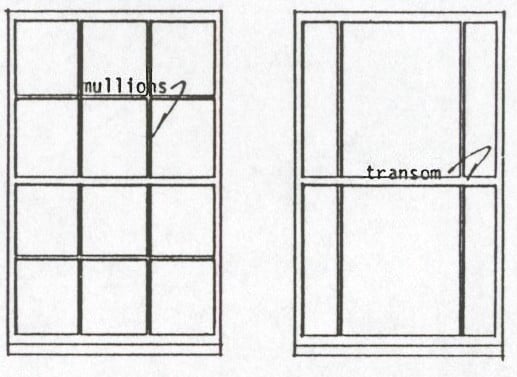
SLIDING SASH AND CASEMENT WINDOWS
Two Alternatives
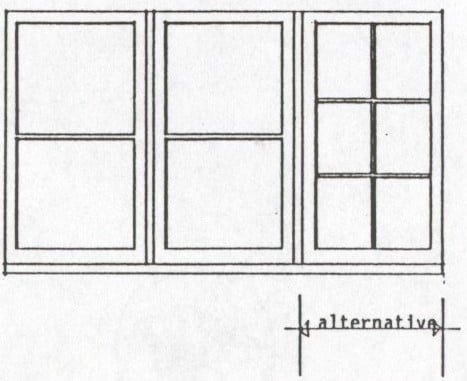
SLIDING OPENING CASEMENTS
INAPPROPRIATE MATERIALS AND DESIGN
Replacement windows in aluminium or PVCu plastic are always unacceptable in listed buildings. Standard casement with top opening or louvre lights as shown below, are always unsuitable and mullions and transoms must always be replaced since these give balance to the window which modern casements seldom have. Of particular importance also is the glass to be used, if at all possible the original glass should be reinserted and where crown glass is used it is most important that this is replaced intact, since the imperfections which are found in the old float glass gives life to a window which unfortunately the modern flat plate glass can never achieve.
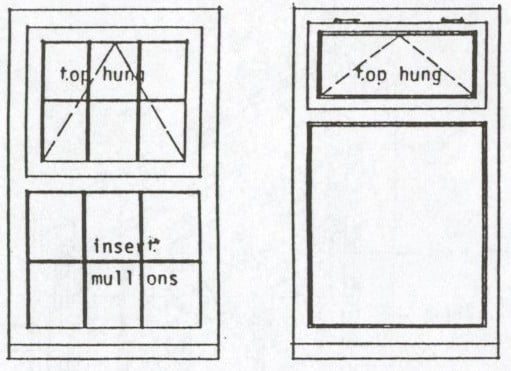
UPVC plastic Timber
Double glazed Double glazed
Double glazed Double glazed
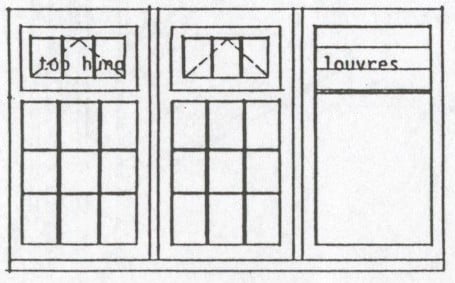
Plastic casement Timber casement
Replacements Replacement
REPAIRS
Full consideration should be given to the repair of the old windows, since in most cases it is the style or the meeting transom sash which has perished, and this is a fairly simple exercise for a competent joiner to repair or replace. The retention of the original timbers which have seasoned and weathered is so much better than replacing with modern soft woods which are unseasoned and kiln dried, and in many cases warp and twist within a short period of time of insertion.
Where double glazing is required, an accepted form of double glazing in listed buildings is the provision of secondary glazing behind the existing window which often consists of two sliding frames set in the inside of the window reveal which during the summer can be removed to give the full benefit of the original window.
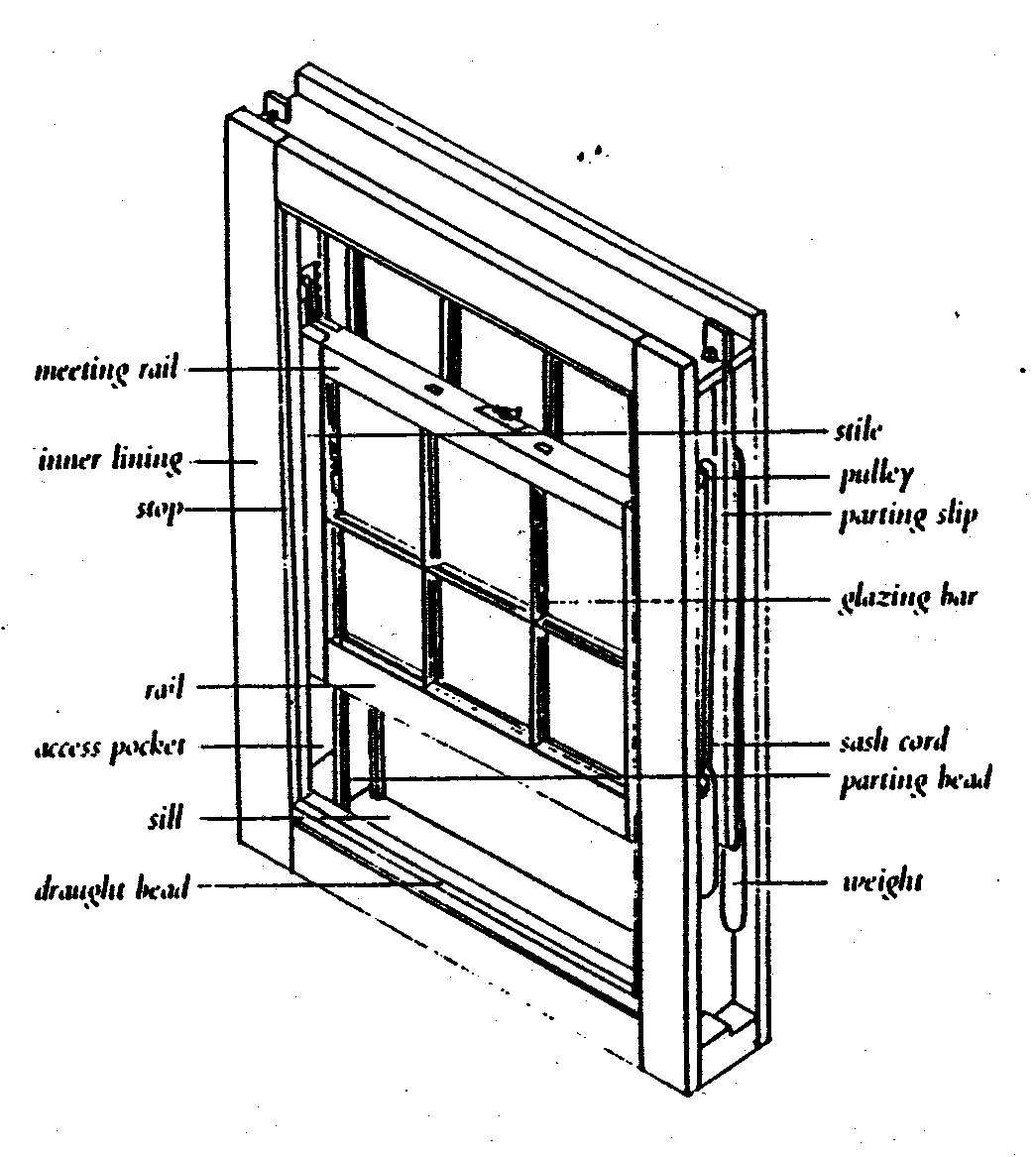
Section through a typical sliding sash and casement window, showing the principle components.
Listed building owners should be aware that owning such a building means holding it in trust for the generations to come, to protect its architectural and historic features, of which windows are one of the most important.
Advice on the type of repairs, materials and craftsmen who can carry out the necessary works can be obtained from the Conservation Officer.
Further advice can be obtained from the Conservation & Design Team at:
Conservation & Design
Planning Services
Seaclose Offices
Fairlee Road
NEWPORT
Isle of Wight
PO30 2QS
∋: 01983 823552
E-mail: [email protected]
Website: www.iwight.com/living_here/planning
List of useful addresses:
Where double glazing is required, an accepted form of double glazing in listed buildings is the provision of secondary glazing behind the existing window which often consists of two sliding frames set in the inside of the window reveal which during the summer can be removed to give the full benefit of the original window.

Section through a typical sliding sash and casement window, showing the principle components.
Listed building owners should be aware that owning such a building means holding it in trust for the generations to come, to protect its architectural and historic features, of which windows are one of the most important.
Advice on the type of repairs, materials and craftsmen who can carry out the necessary works can be obtained from the Conservation Officer.
Further advice can be obtained from the Conservation & Design Team at:
Conservation & Design
Planning Services
Seaclose Offices
Fairlee Road
NEWPORT
Isle of Wight
PO30 2QS
∋: 01983 823552
E-mail: [email protected]
Website: www.iwight.com/living_here/planning
List of useful addresses:
| Society for the Protection of Ancient Buildings 37 Spital Square London E1 6DY | The Victorian Society 1 Priory Gardens Bedford Park London W4 1TT |
| The Georgian Group 6 Fitzroy Square London W1P 5DX | C20th Society 70 Cowcross Street London EC1M 6EJ |
Leaflet: CON5
CONSERVATION
& DESIGN
LIVING IN HISTORIC BUILDINGS
WINDOWS
in
LISTED
BUILDINGS
in
LISTED
BUILDINGS

PLANNING SERVICES
Page last updated on: 10/11/2005





